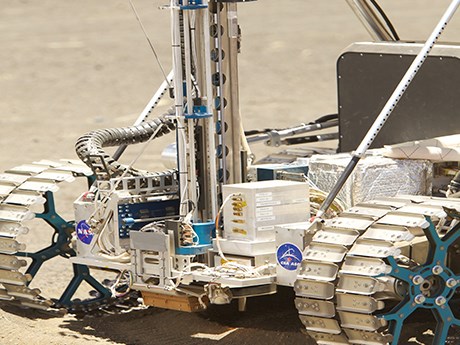There’s a good chance that drills and other mining equipment required by NASA and several commercial enterprises planning exploration and mining missions to the moon will be supplied by the Northern Centre for Advanced Technology (NORCAT) in Sudbury.
The not-for-profit innovation and commercialization centre has been developing drilling technology for use on the moon and Mars since 2000, and is currently working on a $2 million contract to supply a drill for NASA’s RESOLVE project.
The objective, explained Dale Boucher, NORCAT’s director of innovation, is to extract a one metre long core from the Cabeus Crater near the moon’s South Pole, cut it into 12 centimetre bits and feed them to a NASA analysis suite.
In July, NORCAT tested the drill in a mock mission at the 9,000-foot level on Hawaii’s Mono Kea volcano.
“We’re hoping for an announcement shortly that will allow us to plan for a mission to the South Pole of the moon,” said Boucher.
NASA’s LCROSS mission in 2009 detected “massive quantities” of water on the moon by slamming the LCROSS spacecraft’s spent upper stage into the Cabeus Crater and flying another spacecraft through the resulting impact and debris plume to collect and relay data back to Earth.
“Up until this point, everything has been based on remote sensing and orbital data,” said Boucher. “RESOLVE will be the first mission to detect the quantity and quality of the water.”
The drill will operate in temperatures of minus 175 degrees Celsius and will be powered by battery systems and solar cells. It can operate autonomously or can be teleoperated from Earth.
Boucher hopes the drill will be able to hitch a ride to the moon somewhere in the 2017 to 2018 timeframe on a NASA mission. However, NORCAT is also talking to companies that are interested in doing commercial-based exploration.
“These companies are just like any other mining company,” said Boucher. “They don’t necessarily want to get involved with designing, developing and building their own hardware and systems. The cost is too high. Vale, for example, wouldn’t go out and design its own drill. They’d go to Atlas Copco to buy it.
“In talking with Planetary Resources, Shackleton and Moon Express, this is indeed their thinking.”
Asteroids also hold potential for resource extraction, said Boucher.
“There’s a huge number of asteroids. It’s really quite astounding. It’s like a cloud of big rocks in roughly the same orbit as the Earth. Some of them are blocks of ice. Others are big chunks of iron or nickel.”
One asteroid that has been discovered is 98 per cent pure ferronickel, said Boucher.
“It’s estimated to contain one trillion tonnes, so asteroids are very, very rich in resources and can provide a way of ensuring that our resource consumptive society is well provisioned over the long term.”
What’s less clear are the economics of transporting and processing the asteroid-sourced minerals for use on Earth.
The most viable scenario is to mine material as close as possible to the end user.
“Any operator in Northern Ontario knows that,” said Boucher. “You don’t build a mine if your transportation costs are going to drive you crazy. The Ring of Fire is a perfect example. You’re not going to develop the Ring of Fire unless you can figure out how to get the product out of there.
“Mining in space is no different. If you’re going to mine on the moon, you want to have a customer that is on or near the moon. The second best scenario is to have a customer that is somewhere between the moon and Earth. The worst case is to mine on the moon or an asteroid and try to get the material back to Earth. The complexity of that is mind-boggling.”
However, mining the moon or asteroids to produce propellant for sale at refueling depots in low Earth orbit, does make sense, noted Boucher.
“The amount of fuel you need to get from Cape Canaveral to low Earth orbit is the same amount you would need to go anywhere else in the solar system, so if you can get to low Earth orbit and have a refueling depot there, you can now go anywhere in the solar system.”



